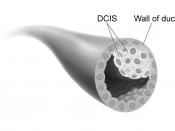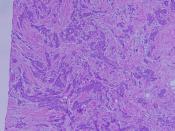Breast Cancer The Canadian cancer society says that you should examine your breast every month. A good time to do it is a few days after the end of your period. If your are between the ages 50-69 you should have a mammogram every 2 years. You should also watch for any changes in your breasts such as lumps, puckered or dimpled skin, or bleeding or discharge from the nipples. If you feel a lump in your breast you should first, be aware that finding a lump is common and that most lumps are not due to cancer. You should call your doctor's office and make an appointment as soon as possible. Your doctor will start by asking you how long it has been since you first noticed the lump, whether it has changed at all, and whether you've noticed any skin changes or irritation. Your risk is higher if: you are older, if it is in your family history and many other reasons.
Our doctor will look for signs that the lump is either "benign"ÃÂ(non-cancerous) or "maligant"ÃÂ(cancerous). The area above your collarbone will be examined to see if the lymph nodes are enlarged. If they are this can be a sigh of cancer spreading. Lumps due to cancer are usually, though not always, painless.
If cancer is suspected you will have to have a mammogram done. This is a x-ray of the breasts. If a cyst is suspected then a ultrasound examination or a technique called "fine-needle aspiration"ÃÂ can help confirm the presence of a cyst. If the lump is fluid-filled the needle will. draw the out the fluid. If blood stained it would then be sent for testing. If the needle doesn't draw out any fluid then they will go about other diagnostic technique such as thermography, light...


